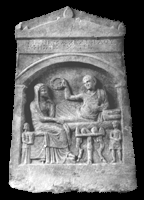
This page includes information that may not reflect the current views and values of the Penn Museum.


According to Homeric belief, when a person died, his or her vital breath
or psyche left the body to enter the palace of Hades, king of the dead. The
psyche once it had fled the body existed merely as a phantom image, perceptible
but untouchable. The wall separating the living from the dead was virtually
impenetrable. A concept of punishments for the wicked and rewards for the
virtuous did not at first play a dominant role in what people believed awaited
them beyond the grave. By Classical times various
secret mystery cults began to promise their initiates a state of blessedness
after death. At the same time ethical considerations led to the proposition
that those who transgressed repeatedly deserved everlasting punishment, while
a just person should gain immortality and perhaps even eternal bliss. Gradually
the psyche became a true soul, separate from the body but serving as the source
of personality and the primary instigator of life's important moral decisions.
From an early time onward concerns about what happened after death gave rise
to a rich assortment of burial rituals and commemorative practices.
Above
Western Asia Minor Marble Funeral Stele
Hellenistic/1st century BC
MS 4023
A man reclines in an arched niche on a tall dining couch or kline. Leaning
on his left elbow supported by a pillow, he holds aloft a funeral wreath.
A woman, probably his wife, is shown in an attitude of contemplation with
her cloak or himation pulled over her head. The three-legged table is laden
with food. Male and female servants, done in a smaller scale in keeping with
their lesser status, fill out the remainder of this melancholy scene. The
inscription across the architrave reads "Worthy Menemachos, son of Diphilos,
farewell."
H. 70.5; W. 47.0; Th. 8.5 cm. UM neg. NC35-3317. (231k)

